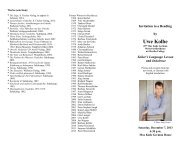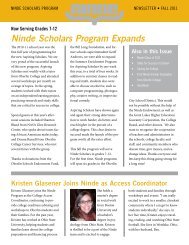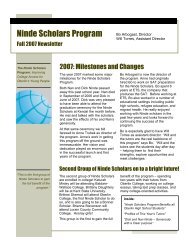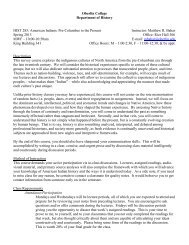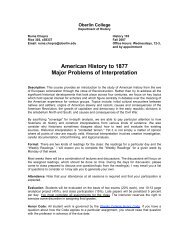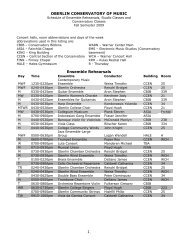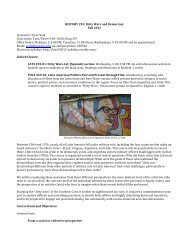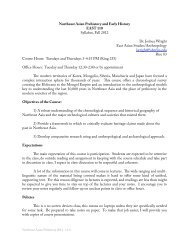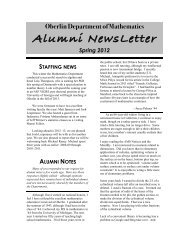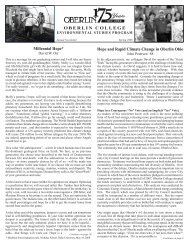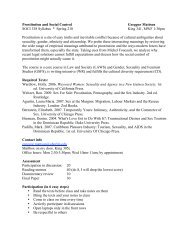10-19 FR Timothy Ruedeman.pdf
10-19 FR Timothy Ruedeman.pdf
10-19 FR Timothy Ruedeman.pdf
Create successful ePaper yourself
Turn your PDF publications into a flip-book with our unique Google optimized e-Paper software.
Wednesday<br />
October <strong>19</strong>, 2011, 8:00 pm<br />
Kulas Recital Hall<br />
Concert No. 28<br />
Faculty & Guest Recital<br />
Ann Roggen, viola<br />
Steven Beck, piano<br />
Tim <strong>Ruedeman</strong>, saxophone<br />
Entartete Musik: Music Banned by the Third Reich<br />
Serenade in F Minor, Op. 73 (<strong>19</strong>22) Robert Kahn<br />
(1865–<strong>19</strong>51)<br />
Suite, Op. <strong>10</strong>2b (<strong>19</strong>49) Hans Gál<br />
Cantabile (1890–<strong>19</strong>87)<br />
Furioso<br />
Con grazia<br />
Burla<br />
Tim <strong>Ruedeman</strong>, saxophone Steven Beck, piano<br />
Trio, Op. 47 (<strong>19</strong>28) Paul Hindemith<br />
I. Solo, Arioso, Duett (1895–<strong>19</strong>63)<br />
II. Potpourri: Schnelle Halbe, Lebhaft, Schnelle Halbe,<br />
Prestissimo<br />
Intermission<br />
Sonata for Viola and Piano, Op. 117 (<strong>19</strong>48) Ernst Krenek<br />
Andante (<strong>19</strong>00–<strong>19</strong>91)<br />
Allegro Vivace<br />
Andantino<br />
Ann Roggen, viola Steven Beck, piano
Suite, Op. 25 (<strong>19</strong>21) Arnold Schoenberg<br />
Präludium (1874–<strong>19</strong>51)<br />
Gavotte-Musette<br />
Intermezzo<br />
Menuett-Trio<br />
Gigue<br />
Steven Beck, piano<br />
Divertimento, Op. 75 (ca. <strong>19</strong>29) Gottfried Rüdinger<br />
Allegro ma non troppo, risoluto (1886–<strong>19</strong>46)<br />
Andante sostenuto<br />
Allegretto<br />
Larghetto<br />
Allegro risoluto<br />
Please silence all electronic devices and refrain from the use of video cameras<br />
unless prior arrangements have been made with the performers.<br />
The use of flash cameras is prohibited. Thank you.
Program Notes<br />
In the <strong>19</strong>20s the Nazis adopted the term ‘entartete’ as a loosely defined technical<br />
concept with which to condemn modern culture. The first exhibition of Entartete<br />
Kunst (degenerate art) took place in Munich in <strong>19</strong>37. The following year an exhibition<br />
of Entartete Musik (degenerate music) took place in Düsseldorf. Atonal music, jazz,<br />
and works by Jewish composers were branded as degenerate and banned throughout<br />
Germany and the occupied territories. The Entartete Musik exhibit featured portraits of<br />
‘defamed’ composers such as Arnold Schoenberg, Ernst Krenek, Anton Webern, Paul<br />
Hindemith, Igor Stravinsky, and Kurt Weill, under which were written crude slogans<br />
attacking their racial origins and moral character. Copies of banned scores, texts, and<br />
listening booths playing banned music were part of the exhibit. Some music was<br />
banned based on its content: atonality, modernism, or programmatic content that did<br />
not conform to Nazi ideology. However, much of the music that was banned was done<br />
so on the basis of the racial and religious origins or the political views of the<br />
composers, regardless of the style and content of the music. Therefore a large swath of<br />
music exhibiting a great diversity of style and genre was labeled as degenerate.<br />
Tonight’s program reflects that diversity and represents music from an array of<br />
composers all of whose lives and careers were irrevocably altered by the events of<br />
mid-20 th Century Europe.<br />
German composer, Robert Kahn (1865-<strong>19</strong>51), received his early musical training at<br />
the Berlin Musikhochschule and the Munich Akademie der Tonkunst. The young<br />
composer came to the attention of Brahms, who invited Kahn to study composition<br />
with him, but that offer was declined out of youthful diffidence. After a period of<br />
military service, Kahn settled in Berlin. Kahn enjoyed considerable success during the<br />
later decades of the nineteenth century. His String Quartet Op. 8 was dedicated to and<br />
performed by the Joachim Quartet, and his orchestral Serenade was given its premiere<br />
by the Berlin Philharmonic under von Bülow. In 1894 he was appointed to the Berlin<br />
Musikhochshule where he taught piano and music theory until <strong>19</strong>30. In <strong>19</strong>16 he was<br />
elected to the Berlin Akademie der Künste. However, his career was halted in <strong>19</strong>34,<br />
when because of his Jewish origins, the Nazis forced his resignation. In <strong>19</strong>37 Kahn<br />
emigrated from Germany to England, where he played little part in the musical life<br />
there. His forced resignation essentially ended his musical career. Kahn died in relative<br />
obscurity in the village of Biddenden in Kent in <strong>19</strong>51.<br />
The Serenade in F Minor (<strong>19</strong>22) was first scored for a trio of oboe, horn, and<br />
piano. However, the composer constructed the work to be played by a variety of<br />
instruments, up to eleven different combinations, all with piano. In style it is not unlike<br />
the early serenades of Brahms. However, unlike Brahms’ serenades, it is constructed in<br />
a single continuous movement, broken into two distinct halves: an Andante sostenuto<br />
in F minor with a contrasting trio, a brisk 2/4 Vivace, and an Allegretto non troppo e<br />
grazioso in F major, with a faster central trio in D major.<br />
Austrian composer, Hans Gál (1890-<strong>19</strong>87), was a prolific composer, teacher, and<br />
scholar. Gál attended the New Vienna Conservatory, where he was a pupil of Richard<br />
Robert. In <strong>19</strong>15 he won the newly created “State Prize for Composition.” That same<br />
year he was drafted into the Austrian army. He continued to compose during his<br />
military service, completing his first important opera Der Arzt der Sobeide, which<br />
launched Gál’s career as an opera composer. During the <strong>19</strong>20s Gál experienced a
meteoric rise in his career as a composer. His opera Die Heilige Ente (The Sacred<br />
Duck) was his greatest success. It was performed in more than twenty theaters,<br />
receiving hundreds of performances, and remained in the repertoire until <strong>19</strong>33. Gál’s<br />
growing popularity brought him into contact with conductors George Szell and Erich<br />
Kleiber, and composers Alban Berg and Anton Webern. During this period Gál coedited<br />
the complete works of Brahms, and numerous other volumes as well. In <strong>19</strong>29 he<br />
was named Director of the Conservatory in Mainz, supported by, among others, Fritz<br />
Busch and Furtwängler. Gál was a leading figure in German musical life, but that<br />
distinction came to a complete and abrupt end in March of <strong>19</strong>33. Shortly after the<br />
Nazis occupied Mainz, Gál was summarily dismissed from his position at the<br />
conservatory and the public performances of his works were banned throughout<br />
Germany and the occupied territories. Gál returned to Vienna and tried to protest his<br />
dismissal, based on his military service to Germany and its Allies. Realizing that his<br />
situation would not improve, in <strong>19</strong>38, he emigrated from Austria to England. England<br />
was not a refuge for long. In <strong>19</strong>40 Gál was arrested and interned at the Isle of Wight as<br />
an “enemy alien.” During the war years, Churchill imprisoned many foreign nationals,<br />
imprisoning actual Nazis side by side with Jewish and political refugees who were<br />
fleeing Nazism. Although the post-war years were filled with uncertainty for Gál, he<br />
did finally receive a teaching position in Edinburgh in <strong>19</strong>48. He became an essential<br />
part of Edinburgh’s musical life, but never regained the popularity and importance he<br />
enjoyed during the Weimar years in Germany and Austria. Gál continued to compose<br />
until his death in <strong>19</strong>87.<br />
Unlike that of many of his contemporaries, Gál’s music does not feature a great<br />
use of dissonance. His use of harmony is inventive, but rarely does it range into the<br />
world of conventional modernism. The Suite for Saxophone and Piano, Op. <strong>10</strong>2b, was<br />
completed in the years <strong>19</strong>49–<strong>19</strong>50, written during his first years in Edinburgh.<br />
Paul Hindemith (1895-<strong>19</strong>63) was one of the foremost German composers of his<br />
generation, and was a figure central to both music composition and musical thought<br />
during the interwar years. He was a prolific composer, theorist, teacher, violist, and<br />
conductor. During the post-war years until his death in <strong>19</strong>63 Hindemith remained one<br />
of the world’s most respected musicians. In recent decades there has been renewed<br />
interest in and scholarship of Hindemith’s music and theories including the<br />
establishment of a Hindemith Foundation, a complete edition of his works, and<br />
celebrations of the centennial of his birth in <strong>19</strong>95. Finding a new creative voice that<br />
could be a champion of the cause of National Socialism was of great importance to the<br />
Nazi party. Older composers such as Richard Strauss and Hans Pfitzner were thought<br />
of as masters of the German Romantic tradition, but not seen as the trailblazers that<br />
would lead German music into the future. A number of people in National Socialist<br />
circles, including conductor Wilhelm Furtwängler, thought that Paul Hindemith might<br />
be that voice. However, Hindemith’s collaborations with Jewish musicians and his<br />
work with twelve-tone music and atonality, did not comply with the National Socialist<br />
aesthetic. Hitler himself took exception to Hindemith’s music and by April of <strong>19</strong>33<br />
over half of Hindemith’s works had been banned in Germany. In <strong>19</strong>38 Hindemith’s<br />
music figured prominently in the Entartete Musik exhibition in Düsseldorf. Realizing<br />
that the situation for him in Germany was worsening, Hindemith emigrated first to<br />
Switzerland and eventually to the United States. In a <strong>19</strong>39 diary entry Hindemith was<br />
self-critical of his behavior under the Nazis: “I always see myself as the mouse who
ecklessly danced in front of the trap and even ventured inside; quite by chance, when<br />
it happened to be outside, the trap closed!”<br />
Hindemith composed his Trio Op. 47 for viola, heckelphone, and piano in <strong>19</strong>28.<br />
The heckelphone, an instrument akin to a tenor oboe, was newly invented at the time<br />
and Hindemith included an alternate part for tenor saxophone (replacing the<br />
heckelphone) in the very first publishing of the piece. The trio, like much of<br />
Hindemith’s music from this period, uses all of the notes of the chromatic scale, but<br />
often melodically distributed to create individual lines that are wholly diatonic.<br />
Ernst Krenek (<strong>19</strong>00-<strong>19</strong>91) was one of the most prolific composers of his time, active<br />
for more than seven decades until his death in <strong>19</strong>91. He played a role in many of the<br />
20th century’s significant artistic movements: atonality, neoclassicism, jazz-influenced<br />
writing, serialism, and avant-garde electronic music. Krenek began his musical studies<br />
in Vienna with Franz Schreker. In <strong>19</strong>20 he moved to Berlin. Between <strong>19</strong>23 and <strong>19</strong>25<br />
Krenek spent time in Switzerland and Paris, returning to Berlin. During this time his<br />
musical and artistic circle included Busoni, Hermann Scherchen, Artur Schnabel, the<br />
poet Rainer Maria Rilke, Theodor Adorno, Milhaud, Stravinsky, Berg, Webern, and<br />
Schoenberg. Krenek’s earliest music was written in a Romantic idiom, but by the early<br />
twenties he had adopted an uncompromising atonal style. Krenek’s music reflects<br />
myriad styles and influences, which were apparent in Krenek’s only unequivocal<br />
public success: the opera Jonny spielt auf (<strong>19</strong>27). Set in nightclubs, glaciers and trains,<br />
and referencing almost all the available styles of the time, including jazz, Jonny was an<br />
instant success. It was performed in dozens of different opera houses and made its way<br />
to New York as early as <strong>19</strong>29. Ironically, the very success of Jonny brought Krenek to<br />
the attention of the Nazis. The vernacular styles, especially its “jazziness” and the<br />
character Jonny, a black jazz musician, made Krenek’s opera a convenient target for<br />
the Nazis. Jonny was a major focus at the <strong>19</strong>38 Düsseldorf Nazi exhibition of<br />
degenerate music. Krenek made his second visit to the United States in <strong>19</strong>38 and had<br />
originally planned to return to Austria; however, the Anschluss of <strong>19</strong>38 made that<br />
return impossible. Krenek remained in the US and accepted a teaching position at<br />
Vassar College. In <strong>19</strong>42 he accepted a position at Hamline University in St. Paul,<br />
Minnesota, and in <strong>19</strong>47 he moved to California, where he spent the rest of his life in<br />
Los Angeles and Palm Springs. Krenek’s time in the US was extremely prolific. He<br />
produced over <strong>10</strong>0 compositions during his time in California. Starting in the <strong>19</strong>60s<br />
Krenek regained some of the recognition he had received as a younger man and was<br />
honored in many ways. His music was often programmed and many festivals of his<br />
work were mounted, especially in California.<br />
The Viola Sonata, Op. 117 was completed in Los Angeles in just four days.<br />
Krenek departs from conventional 12-tone rules, using a freer atonal and serial<br />
technique. It is structured in three movements: Andante, Allegro vivace, and<br />
Andantino.<br />
Austrian composer Arnold Schoenberg (1847-<strong>19</strong>51) was the leader of the Second<br />
Viennese School of composition and a pioneer of twelve-tone music. During the <strong>19</strong>20s<br />
and early <strong>19</strong>30s Schoenberg was one of the leading figures in German musical life.<br />
Among his most famous pupils were Alban Berg and Anton Webern. In <strong>19</strong>33<br />
Schoenberg was forced to leave his position at the Akademie der Künste in Berlin after<br />
the Nazis announced that all Jewish elements were to be removed from the academy.<br />
Schoenberg and his music figured prominently in the <strong>19</strong>38 Entartete Musik exhibition
in Düsseldorf. Citing Schoenberg as the father of twelve-tone music, Nazi critics often<br />
identified twelve-tone or atonal music as specifically Jewish. In <strong>19</strong>33 Schoenberg fled<br />
Germany, immigrating to the United States where he found work as a teacher, first in<br />
Boston, then in Los Angeles at the University of Southern California. Although<br />
Schoenberg continued to compose and held teaching positions he was never again to<br />
enjoy the stature and success that he did in the prewar years in Germany.<br />
Schoenberg began composing the Suite for Piano, Op. 25 in <strong>19</strong>21 and<br />
completed the piece in February and March of <strong>19</strong>23. The suite is the first of<br />
Schoenberg’s pieces that is wholly dodecaphonic. It is structured in five movements:<br />
Prelude, Gavotte-Musette, Intermezzo, Minuet-Trio, and Gigue.<br />
Gottfried Rüdinger (1886-<strong>19</strong>46) was a German composer and teacher. He studied<br />
composition with Max Reger in Leipzig and church music under Wilhelm Widmann at<br />
Eichstätt Cathedral. In <strong>19</strong>20 Rüdinger was hired as a member of the theory staff at the<br />
Academy of Music in Munich. In <strong>19</strong>38 he was named as a full professor and continued<br />
to teach there until his death.<br />
In <strong>19</strong>33 the Nazi regime started a series of loosely connected efforts to foster<br />
the development of local music talent. An attempt was made to recruit new artists<br />
willing to cultivate a style that was consistent with the tenets of National Socialism:<br />
bolder than the Romantic music of the past, but stopping short of ‘Jewish’ atonal or<br />
twelve-tone composition. The result of that narrow and somewhat ambiguous agenda<br />
was the purging or silencing of the most talented composers in Germany and the<br />
occupied countries. Gottfried Rüdinger was among a younger generation of German<br />
composers who were allowed to continue to compose music. That group included<br />
lesser-known composers such as Kurt Stiebitz, Otto Besch, Albert Jung, Hermann<br />
Simon, Ulf Scharlau, Bruno Stürmer, and Cesar Bresgen. Rüdinger’s music received<br />
attention in the press, including a feature article in the Algemeine Zeitschrift fur Musik<br />
in January of <strong>19</strong>34. There are several notices of performances of his works throughout<br />
Germany documented in that journal during the years <strong>19</strong>34–<strong>19</strong>35, but very little<br />
mention of Rüdinger after that. It is likely that Rüdinger was a beneficiary of the<br />
purging of Germany’s pool of composers, and rose to more prominence than he would<br />
have otherwise. Of his approximately 150 compositions, the last third (from the war<br />
years) remain unpublished.<br />
The Divertimento for viola, tenor saxophone, and piano, Op. 75 was composed<br />
in the late <strong>19</strong>20s, around the same time as Hindemith’s Trio (<strong>19</strong>28) for the same<br />
instrumentation. The piece reflects the influence of Rüdinger’s teacher Max Reger, as<br />
well as his use of Bavarian folk-tunes in his concert music.<br />
~ Notes by Tim <strong>Ruedeman</strong>




